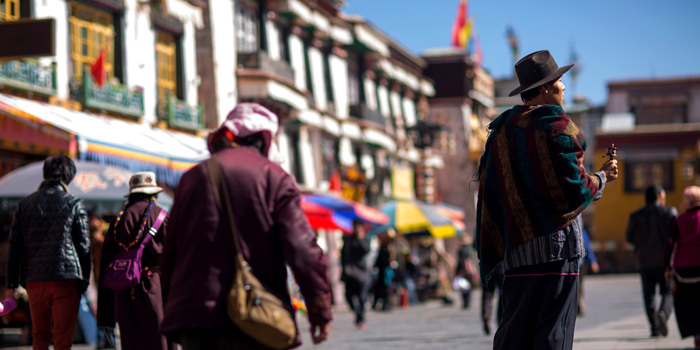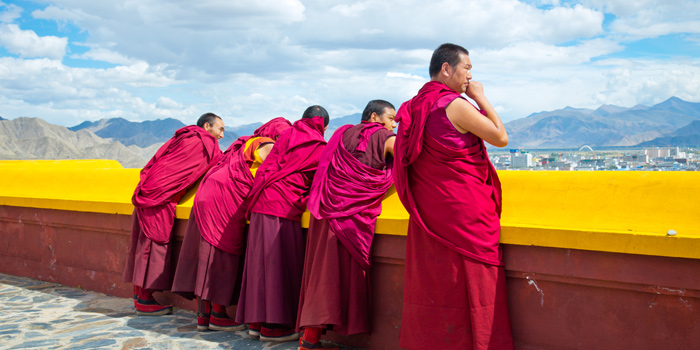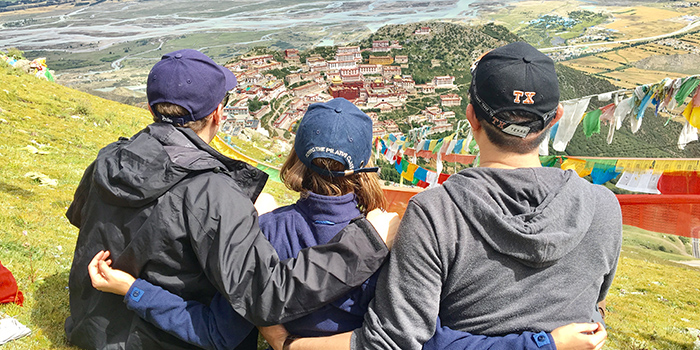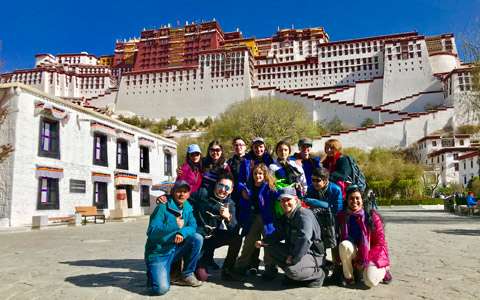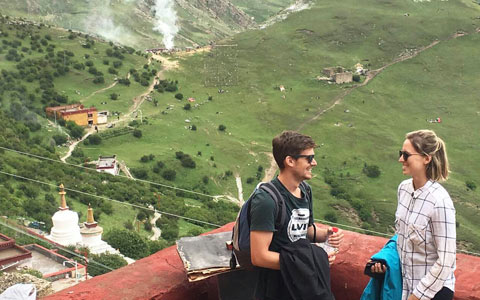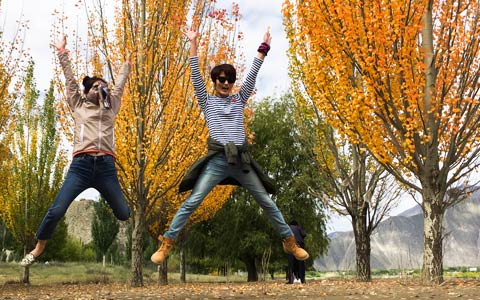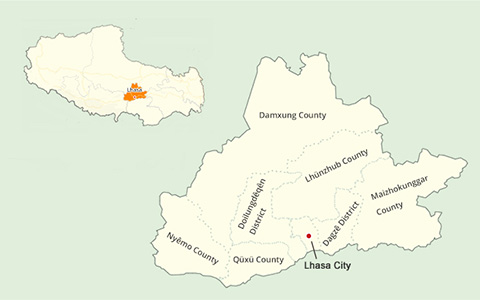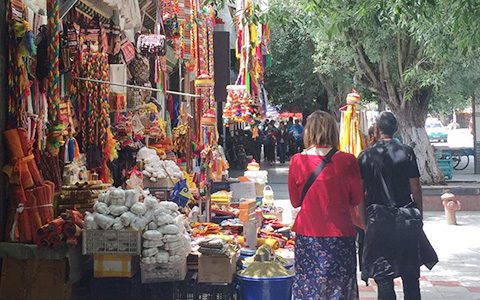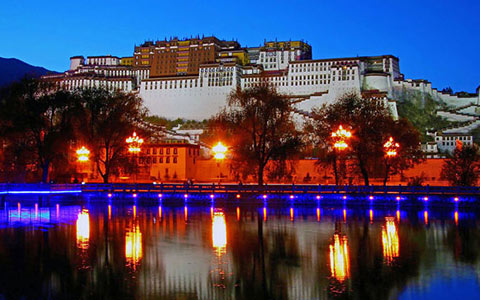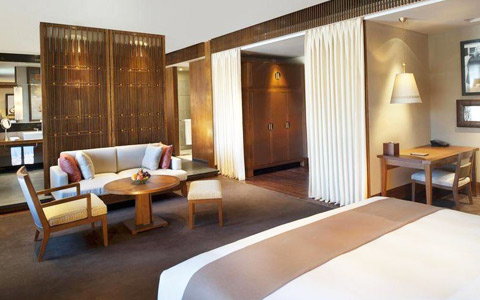Lhasa Pilgrim Circuits and Kora: top spiritual walk you should know in Lhasa
Lhasa, a Buddhist sacred city honored with a long history, has attracted hundreds and thousands of tourists and pilgrims at home and abroad because of its historic sites and scenic beauty. There are lots of monasteries in Lhasa. Almost around every monastery, there is a kora or pilgrim circuit in Lhasa. The Lhasa pilgrim circuits, particularly the Barkhor Pilgrim Circuit, are the ultimate pilgrimage destination for pilgrims.
 Top 1 Pilgrims Circuit in Lhasa City: Barkhor Kora
Top 1 Pilgrims Circuit in Lhasa City: Barkhor Kora
 Top 2 Pilgrims Circuit in Lhasa City: Nangkhor Kora
Top 2 Pilgrims Circuit in Lhasa City: Nangkhor Kora
 Top 3 Pilgrims Circuit in Lhasa City: Tsekhor Kora (Potala Kora)
Top 3 Pilgrims Circuit in Lhasa City: Tsekhor Kora (Potala Kora)
 Top 4 Pilgrims Circuit in Lhasa City: Lingkhor Kora
Top 4 Pilgrims Circuit in Lhasa City: Lingkhor Kora
What is Kora in Tibet?
Kora means a pilgrimage circuit in Tibetan. You know every Tibetan does a ritual walk. When you are making a tour in Tibet, it is common to see Tibetans walking around a temple, turning prayer wheels and muttering mantras. There are four famous pilgrimage circuits in Lhasa City, Nangkhor Kora, Barkhor Kora, Tsekhor Kora, Lingkhor Kora, and scenic Ganden Kora in the suburb of Lhasa.
Nangkhor is a circuit encircling the inner precincts of Jokhang Temple; Barkhor circuits the outskirts of the Jokhang; Tsekhor loops the Potala Palace; Lingkhor encompasses the entire old city of Lhasa; and Ganden Kora surrounds Ganden Monastery with views of Kyichu Valley. Among them, the Barkhor is the most famous pilgrimage circuit in Lhasa and the best introduction to the old Lhasa city for newcomers. Tibetans normally do a ritual walk along the Barkhor and do Lingkor during the Saga Dawa Festival.
Top 1 Pilgrims Circuit in Lhasa City: Barkhor Kora
The most famous pilgrim circuit in Lhasa is Barkhor Kora or Barkhor Pilgrim Circuit circling the ancient Jokhang Temple. On Barkhor Street, you can see thousands of people with prayer wheels, Buddhist prayer beads, or incense walking clockwise around the Jokhang Temple. Follow this Lhasa pilgrim circuit, you can get a feel for Tibetan arts, handicrafts, and customs. This kora is lined with traders selling everything, as well as small alleyways leading to temples, markets, and homes. Therefore pilgrims can do shopping at the end of their kora. Barkhor Street is always thronged with pilgrims from all over Tibet, even from other places of the world. Some of them have covered thousands of kilometers to complete this sacred circuit. Some of them, even teenagers, move forward body-lengths by body lengths from morning to night. All they do is to testify their piety to their beliefs. It is here that you can witness the devotion of the pilgrims and directly feel the strength of religion.
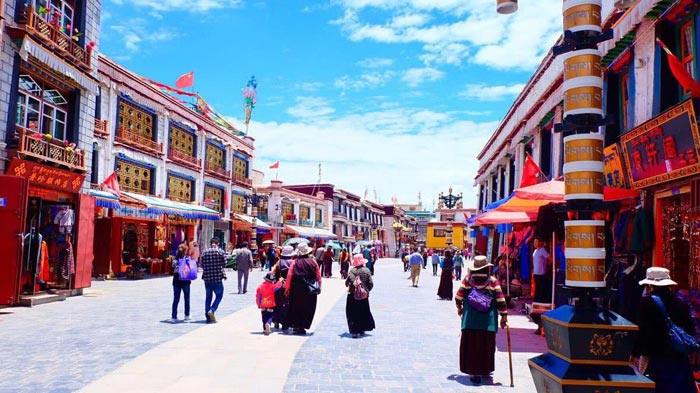 Local Tibetan families are following the Barkhor Kora around Jokhang Temple
Local Tibetan families are following the Barkhor Kora around Jokhang Temple
Top 2 Pilgrims Circuit in Lhasa City: Nangkhor Kora
Besides the Barkhor Kora, there is another kora around the Jokhang Temple, Nangkhor. Nangkhor Kora is the innermost circumambulation path around the sacred Jokhang Temple. Nangkhor Kora is not as famous as Barkhor, but you can enjoy many kinds of delicacies on this kora, such as fried potatoes and noodles.
Top 3 Pilgrims Circuit in Lhasa City: Tsekhor Kora (Potala Kora)
One more of Lhasa's Pilgrim Circuit is Potala Kora around the famed Potala Palace. Potala Kora, also known as Tsekhor, encircles the Potala, passing by an almost continuous circuit of prayer wheels, chortens, rock paintings, and Lukang Temple. Thousands of pilgrims with prayer wheels, Buddhist prayer beads, and incense walked clockwise around the Potala. It was not just the old people, but people of all ages who did koras. The pilgrims who have come from afar prostrate themselves along the entire route. Once again, follow the kora and feel the mysteries of Tibet.
Top 4 Pilgrims Circuit in Lhasa City: Lingkhor Kora
Lingkhor Kora is another famous one of Lhasa's pilgrim circuits. Lingkhor is also a sacred path, most commonly used to name the outer pilgrim circuit in Lhasa matching its inner twin Barkhor. The Lingkhor Kora is 8 kilometres long enclosing Old Lhasa City, the Potala, and Chakpori. In the past, it was crowded with men and women moving forward body-lengths by body lengths or by their knees to cover its lengths. This Kora passed through willow-shaded parks where the Tibetans used to picnic in summer and watch open-air operas on festival days. Unfortunately, most of Lingkhor has been wiped off by New Lhasa; only one stretch still remains west of Chakpori. The Lingkhor stretches left before a bridge between walls and willow trees. The bridge is about 1 km west of the Potala.
The Most Scenic Kora in the Suburb of Lhasa: Ganden Kora
Located 57km away from Lhasa City, Ganden Monastery towers on the Wangbori Mountain with an altitude of 4,500 meters above sea level. Trekking along the trail, you can capture the charming view of Lhasa Valley with the Lhasa River running through. The best time for Ganden Kora is from April to mid-November with crystal streams trickling down, wildflowers flourishing here and there, prayer flags fluttering in the breezes, yaks grazing on the hill, herds’ tents scattering en route.
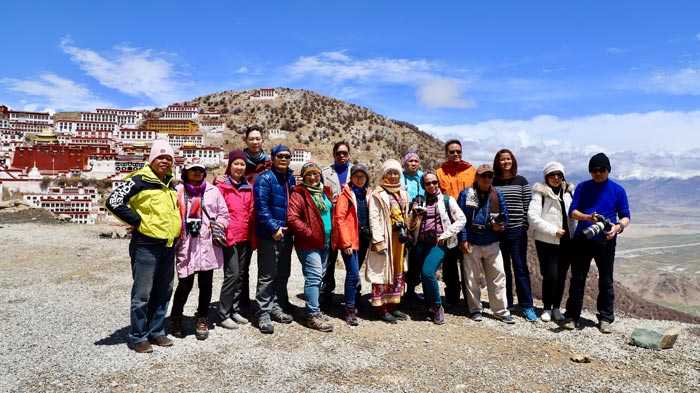 Our clients have completed the kora around Ganden Monastery
Our clients have completed the kora around Ganden Monastery
The Ganden kora is a stunning walk with views of Kyichu Valley along the way. Besides, you can also meet large numbers of pilgrims and monks offering prayers, rubbing holy rocks and even prostrating all the way. In fact, the Ganden Kora has two parts, a higher kora and a lower kora. The higher one climbs Angkor Ri south of Ganden and then drops down the ridge to join up with the lower kora.
The higher kora starts at the path southeast of the car park. After walking for a while, you will find the track splits – the left path stretches to Hepu village on the way to Ganden-Samye trek, while the right path zigzags up the ridge to a collection. Follow other pilgrims and you will reach the top of the ridge after 40 minutes.
The lower kora is much easier than the higher one. It only takes you 45 minutes to finish the whole kora. Start from the car park, head west, pass a new police station, and then walk around the back of the ridge behind the monastery. The track winds past several isolated shrines and rocks. Before reaching the highest point of the trail, you will see a sky burial site.
Towards the end of the kora is Tsongkhapa’s hermitage where there is a small building housing relief images of Atisha, Sakyamuni, Tsepame, and Palden Lhamo. From the hermitage, the kora drops down to rejoin the monastery.
Dos and Don’ts When Enjoying the Kora in Lhasa
1. For travelers, all the circuits are well worth following, during Saga Dawa Festival in particular, when the distinction between tourists and pilgrims can become very fine indeed. You need to always proceed clockwise during the pilgrimage walk.
2. If you want to take photos of Tibetan pilgrims, please do ask their permission first and respect their willingness.
3. Please do respect Tibetans’ beliefs and lifestyle and avoid conflict with local residents.
4. While shopping in Lhasa, you’d better take our Tibetan tour guide's advice to avoid unnecessary disputes.
5. Take it easy to follow pilgrimage kora in Lhasa and never push yourself to complete all the circuits.
6. Due to the intense ultraviolet radiation, please put on a sunhat, sunglasses, and sun cream to protect yourself from sunburn while touring Lhasa.
7. It’s suggested to wear in layers so you can add or subtract the clothes easily.
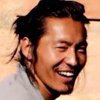
Energetic, responsible and reliable, Sonam is a guide with more than seven years experience informing visitors about heritage sites and attractions places in Tibet.
Related Articles & Posts
Most Popular Tibet Tour Packages
-

Lhasa - Gyantse - Shigatse - Everest Base Camp - Shigatse - Lhasa
USD939
View Details -

Lhasa - Gyantse - Shigatse - E.B.C - Saga - Kailash Trek - Darchen - Lake Manasarovar - Saga - Gyirong - Tingri - Lhasa
USD2059
View Details -

10 Days Lhasa to Everest Base Camp and Namtso Lake Small Group Tour
Lhasa - Gyantse - Shigatse - EBC - Shigatse - Lhasa - Namtso Lake - Damxung - Lhasa
USD1289
View Details -

8 Days Driving Across Himalaya Overland Adventure from Kathmandu to Lhasa
Kathmandu - Gyirong - Everest Base Camp - Tingri - Shigatse - Gyantse - Lhasa
USD1069
View Details -

4 Days Lhasa Impression Small Group Tour: Explore the Heart of Tibet and Mingle with the Locals
Lhasa
USD509
View Details -

Lhasa - Gyantse - Shigatse - Everest Base Camp - Gyirong - Kathmandu
USD979
View Details -

Lhasa - Gyantse - Shigatse- Lhasa
USD799
View Details -

13 Day Lhasa, Mt. Everest, Mt. Kailash, Lake Manasarovar and Kathmandu Adventure Tour
Lhasa - Gyantse - Shigatse - EBC - Saga - Darchen - Kailash Trek - Darchen - Saga - Gyirong - Kathmandu
USD2059
View Details


.jpg)



